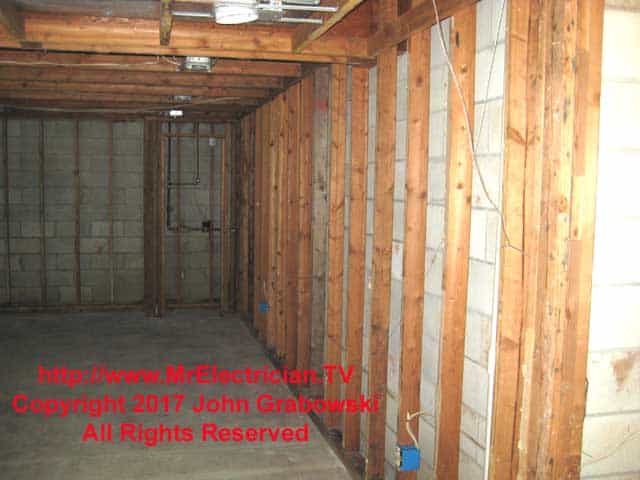Dear Mr. Electrician: I am trying to determine the cost for basement renovations. I called several carpenters, plumbers, electricians, and heating contractors to give me estimates and suggestions on what could be done. The prices that they came back with are all over the place. Not one contractor’s quote in any trade is close to another’s. Why?
Answer: In order for you to determine your basement renovations cost for remodeling your basement by contractors, you need to start with a drawing and some specifications. You are off to a good start by meeting with contractors.
Table of Contents:
NOTE: Text links below go to applicable products on eBay and Amazon. As an Amazon Associate, I earn from qualifying purchases. Using my links helps to keep this website FREE.
Having plans and specifications determined by you will enable you to compare estimates because each contractor will be bidding on the exact same work.
The more planning that you have done ahead of time, the more power you will have to make informed decisions and keep the work moving along. This applies to any home improvement project.
FIGURING COST OF BASEMENT RENOVATIONS
Draw sketches and/or plans on your own. Write down exactly what you really want as far as design, layout and materials. Determine what would be nice to have if you had the money. Figure what you might want to add later after you’ve finished paying for the initial project.
By having plans and specifications, you can communicate your wants and needs easier to contractors and ultimately arrive at an affordable cost to remodel your basement.
Something else you should consider when determining the cost of a basement renovation is the time allotted for construction. Do you want it done quickly? Or is having it done cheaply your top priority?
In construction, I agree with the general rule of thumb: Fast, cheap, or good – pick any two. You can get your basement remodeling done very cheaply and very fast, but the quality of construction will suffer. You can have the work done fast and good, but it will be much more expensive than a standard construction schedule.
Regardless of your budget and time constraints, planning is still key to a successful outcome.
Put together a list of specifications for materials such as brand of windows, type of heating/air conditioning system, lighting, flooring, sinks, toilets, etc.

The photos above and at the top are from a home that had a finished basement. A pipe froze upstairs when the place was unoccupied and flooded everything below.
Don’t overlook small details like the choice of faucets, wall switches, dimmers, electrical receptacles, cable TV jacks, telephone jacks, network connections, paint, molding, doors, etc.
Not all materials are the same. There are different grades of quality for everything. The building codes only specify minimum standards. You decide if you want better quality materials.
If you do not know what you want for your basement renovations, you should look at other similar projects. Talk to your neighbors, co-workers, friends, and relatives. Go to design showrooms. Look in magazines and books. Talk to suppliers.
This is a lot of work, but you must do homework to get what you want from your home improvement project. How can you expect your contractors to know if you don’t know what you want?
If you cannot handle all of the pre-planning for a basement renovation, you can hire an interior designer to help you or to take on the entire design process.
Include garbage disposal in your specifications. Are you willing to take on the task of disposing of construction debris yourself to save money? If not, your contractor should have a legal means for disposing of everything leftover from the basement remodeling process. Many get an appropriately sized dumpster and leave it on the property for the duration.
I have cut into walls a few times and found construction debris that someone hid there instead of disposing of it properly.
Waste Management has a folding Bagster, a big bag you buy and fill up with construction debris. You leave it in an accessible spot in your driveway, and for a one-time fee, they will remove the entire bag with its construction scrap contents.
What about your long-term needs? Do you plan on living in your house until you can no longer care for yourself? If so, consider installing accessibility features to make things easier as you age.
Grab bars, wheelchair-accessible showers, lower wall switches, and higher electrical receptacles are all things that will make life a little easier as it becomes more difficult.
Take a look at the ADA Standards for Accessible Design.
A bedroom in the basement must have an egress window big enough for someone to climb out of during a fire. It should be low for an elderly person.

FINDING A CONTRACTOR FOR RENOVATIONS
Finding good people to do quality work on your home is not always easy. Ask everyone you know for contractor referrals. Friends, relatives, neighbors, people you work with, and people you do business with, such as your letter carrier, banker, or doctor.
There are design/build contractors available. They have designing and/or architectural abilities and the means to build your project. These contractors are popular because your contractor is on board during the planning process and can provide input from a build aspect as well as design. In addition, your designer is available during the build process to ensure the project is being built as planned.
If needed, have an architect draw your plans. Make sure that you get plans drawn for electrical, plumbing, and heating/air conditioning in addition to the structural and foundation drawings.
Have a set of specifications compiled (You can do this) for each trade that tells the contractor exactly what materials you want to be installed, such as Decora-style electrical receptacles and switches instead of the standard face type. It would be best to include the manufacturers’ names and part numbers.
If you plan on purchasing some items, such as toilets, sinks, and light fixtures, put that in the specifications as owner-supplied.
Once all of these plans are drawn, go to a photocopy store (Not all of them can do this) and get full-size photocopies of all the drawings and specifications. Photocopies are much cheaper than the certified plans furnished by architects, which are given to the town building department for review.
Next, solicit bids from at least three contractors by giving them each a COMPLETE SET of photo-copied drawings and specifications. That way, each contractor will bid on the same type of work and materials.
Suppose you don’t have your own plans and specifications for your basement renovations. In that case, the contractor will determine his or her own specifications, which may have higher or lower standards than yours. In that case, you would have no idea if you are getting a good deal because you cannot compare apples to apples.
If the bids come back too high, consider ways to save money. Perhaps you could do some work yourself, such as insulating and painting. Another way to save is to tell each contractor you will be responsible for cleaning up the job site and disposing of the trash.
You could act as your general contractor and solicit bids from each trade. You could also cut some things out for now that can be added later. For instance, suppose you wanted recessed lighting everywhere, but it significantly costs your electrical price. Have the electrician install the switches and some wiring up into the ceiling to feed the lights, but install the recessed cans when your budget allows.
The bathroom plumbing could be roughed in now and finished when you have more time and money.
Good planning is the key. On some projects, it should take you more time to plan than it does for the actual construction.
A woman that I knew professionally kept telling me for at least two years about her planning to remodel her kitchen. I always responded, “Call me when you’re ready”. So she did, and when I got there, she had two fat 3-ring binders of not only drawings and specifications but also samples of her chosen ceramic tile, vinyl flooring, cabinet wood & color, and paint colors.
All appliances were chosen, and she had specifications for all of them. She spent two years planning it all. The result was magnificent, and she got exactly what she planned for.
Having all of the specifications available is extremely helpful to me as a contractor. I know what the exact requirements are so I can give a more accurate estimate of the final cost. During the work process, I can refer to the specifications if any questions come up.
Do not skimp on permits and building inspections during your basement changes. Double-check with the local building department about needed permits and inspections before the work begins. Do not take the word of a contractor who tells you not to bother with permits.
Permits and inspections protect you and the contractor by certifying that the work meets minimum building code standards.
BASEMENT DESIGN CHOICES
Regarding choosing a design for your basement renovation, I suggest you look at your neighborhood. What have the neighbors done? Will your idea for a design be consistent with the house’s original architecture? When finished, will it look like an addition from the outside, or will it look like it was an actual part of the house?
There are many books and magazines with pictures of homes in them. Browse through them for ideas. Avoid unproven materials and manufacturers with short track records.
Submit the plans to your town for approval, have your chosen contractors apply for necessary permits, and ensure that all rough and final inspections occur. Be wary of any contractor who doesn’t want permits and inspections.
You might be interested in some of my other planning posts.
Click here to see the information that This Old House has about basement renovations.
To help keep this website FREE, please use this Amazon link for your purchases. As an Amazon Associate, I earn from qualifying purchases.
Click for a FREE copy of my book “Almost Everything You Need To Know To Repair a Bathroom Exhaust Fan In Your Home.”
Get your required “Emergency Disconnect, Service Disconnect” labels and stickers to satisfy the 2023 National Electrical Code requirements in article 230.85(E)(1) and (2) by going to my Redbubble Shop here.
Visit my Link Tree for my social media connections and links to merchandise in my Redbubble Shop.










